How to Dehydrate Tomatoes
This post may contain affiliate links.
Make the most of the summer harvest by dehydrating your own tomatoes!
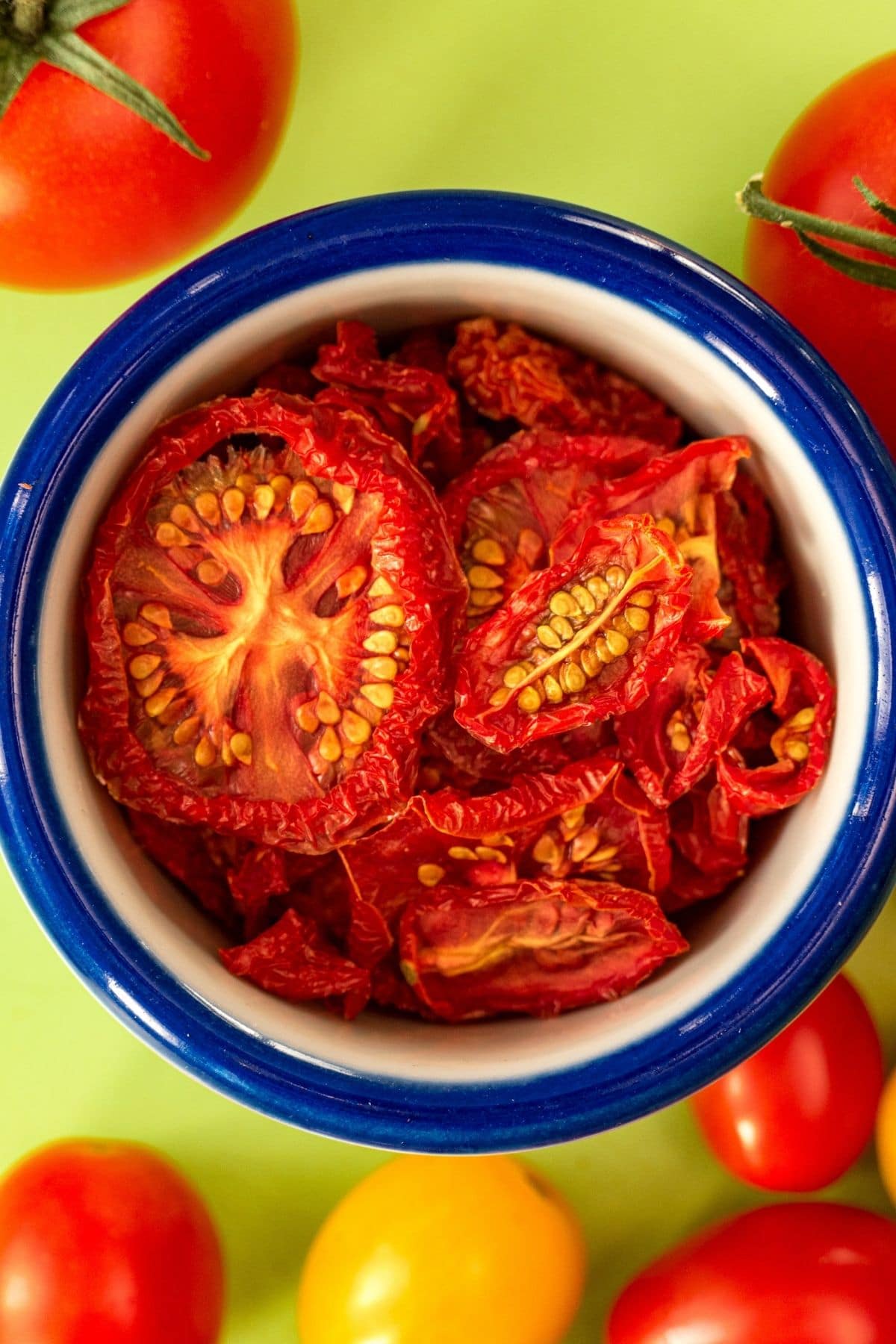
Summer is the high season for tomatoes. Obviously, you can find plenty of tomatoes all year round at the supermarket. But summer is when the quality of tomatoes goes through the roof. From your home garden to the farmer’s market, the sun-ripened tomatoes of summer are not to be missed.
But as quickly as tomato season arrives, it departs with the arrival of fall. This is why it’s a great idea to dehydrate your tomatoes to be used throughout the year!
Dehydrating tomatoes is incredibly simple. In fact, they are one of the best ingredients for beginners to start with. Dried tomatoes retain their bright summer flavor and maintain most of their nutrients. But, if properly stored, they can be shelf-stable for upwards of a year!
So if you want to capture the magic of summer tomato season, we’ve got everything you need to know to start dehydrating your own tomatoes at home below!
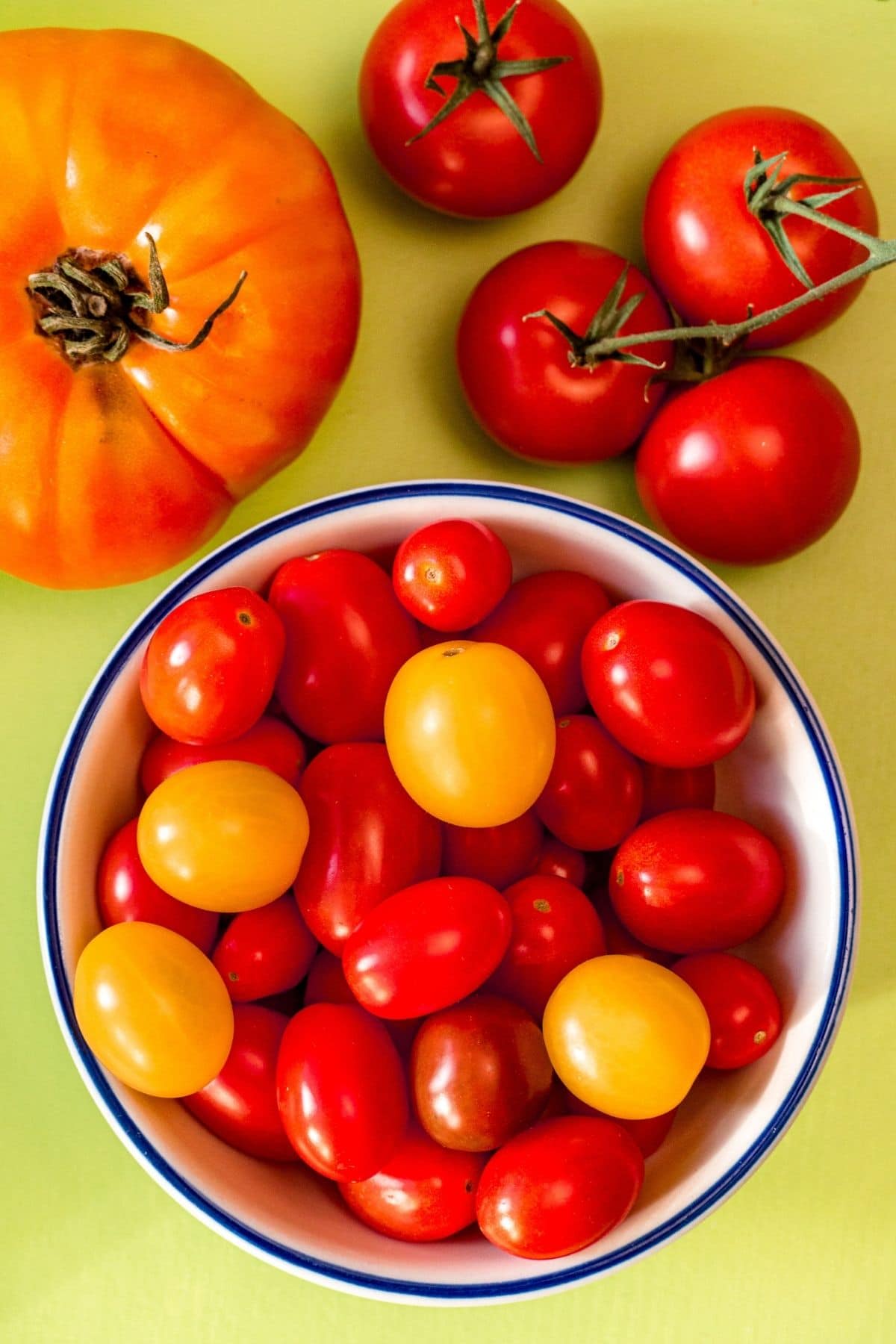
What Type of Tomatoes Can Be Dehydrated?
All types of tomatoes can be dehydrated! That includes the little cherry tomatoes that you grow in your home garden, heirloom tomatoes from the farmer’s market, plum tomatoes from the grocery store, and even canned tomatoes! They will all work!
While any tomato can be dehydrated, we highly recommend selecting organic tomatoes if possible. That’s because tomatoes are one of the “dirty dozen” fruits and vegetables more likely to contain pesticide residues.
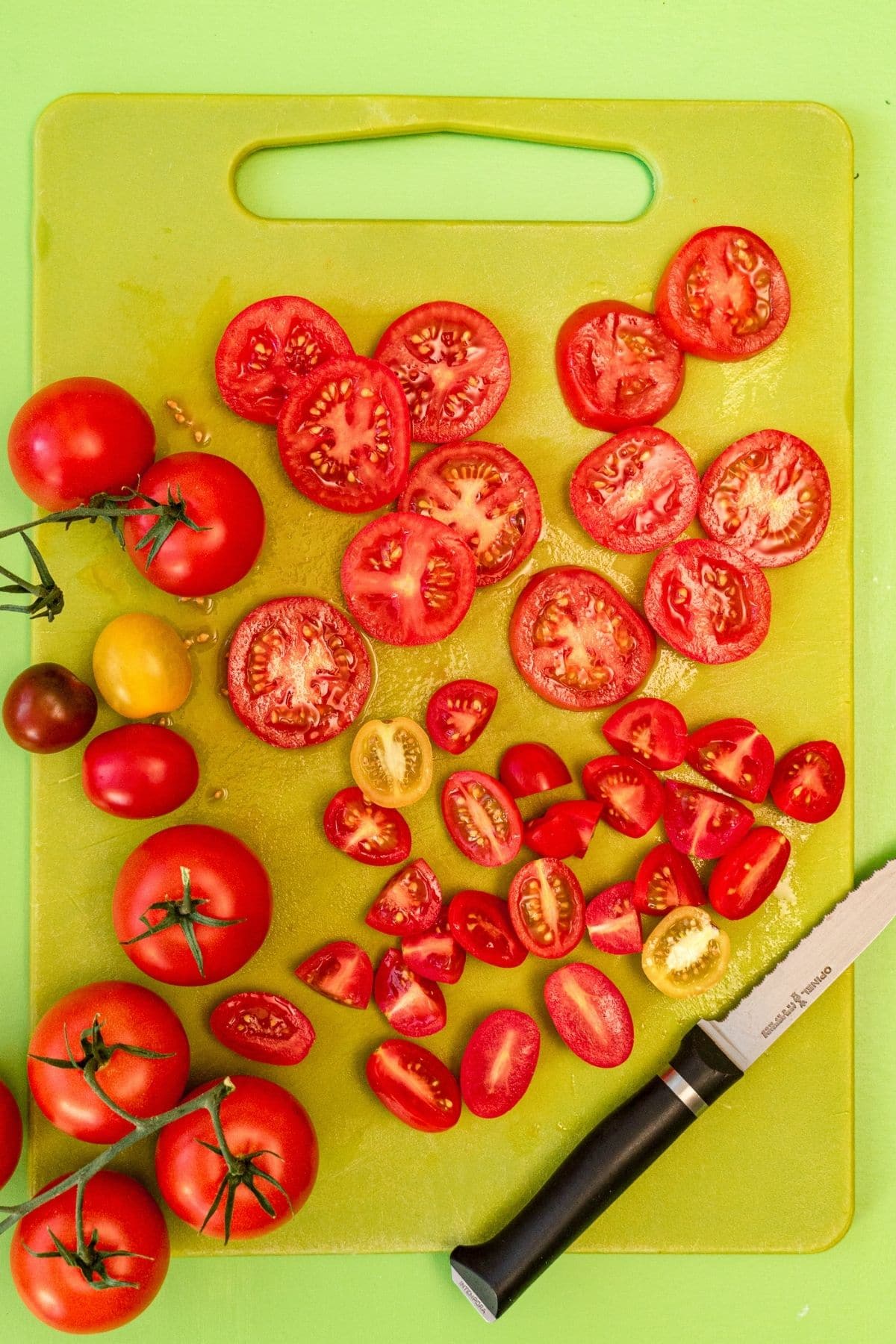
Prepping and Pre-Treating Tomatoes for Dehydration
Before you start prepping your tomatoes, make sure your counters, equipment, and hands are clean & sanitized to prevent contamination, which can spoil your batch down the line.
- Whether you have organic tomatoes or not, it’s a good idea to wash them. Since tomatoes have thin skin and don’t take being scrubbed well, the best way to thoroughly clean them is to soak them in a 50/50 water-vinegar solution for a few minutes.
- Tomatoes need to be sliced into pieces to properly dry. Most cherry tomatoes can be sliced in half, although larger ones should be quartered. Bigger tomatoes should be cut up into slices no thicker than ¼ inch.
- [Optional] You can remove some or all of the seeds & gel from the inside of the tomatoes using a small spoon. There is absolutely no harm in leaving them, but if you don’t want them, this is the time to remove them.
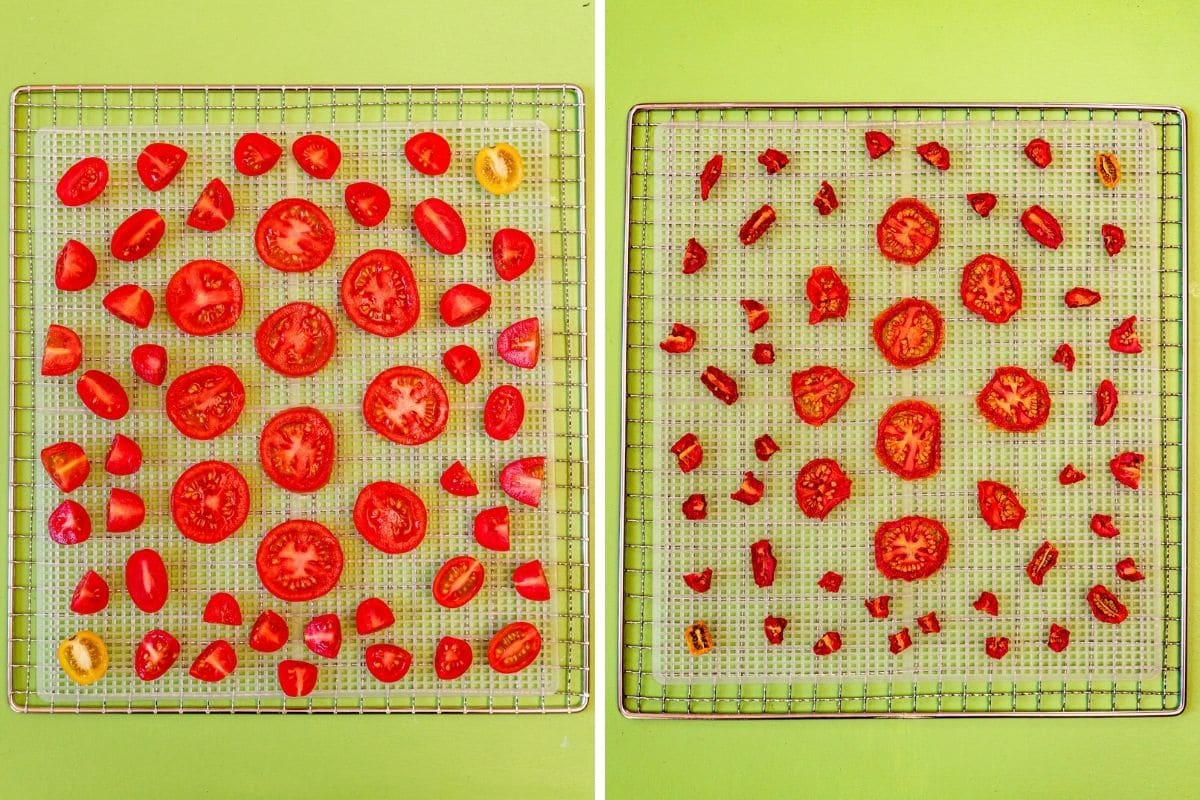
How to Dehydrate Tomatoes
Dehydrating tomatoes is incredibly easy—a great ingredient for beginners! Once your mangoes are prepped, set up your dehydrator and follow these steps:
- If you’re using a tray that has large holes, line it with parchment paper or, better yet, a mesh liner cut to the size of your tray. Leave space between the pieces to allow air to circulate.
- If possible, place skin side down (ex. halved cherry tomatoes). Tomatoes contain sugar-rich juices which can cause them to stick to the try when dehydrated. So if possible, place them skin down, cut side up.
- Dehydrate at 125ºF (52ºC) for roughly 8-14 hours until the tomatoes are dry and leathery.
- Depending on your machine, you may need to rotate the trays every so often to promote even drying.
- Drying tomatoes in the oven: Place the tomatoes in a single-layer baking sheet lined with a silicone mat (this will prevent sticking). Dry in the oven on its lowest temperature setting—if possible, keep the door propped open to allow steam to escape (be careful if you have children or pets!). Flip the pieces over every hour and remove them as soon as they are completely dry.
Equipment Spotlight: Dehydrators
If you’re in the market for a dehydrator, we recommend buying one with an adjustable temperature. This will allow you to dial in the drying temp to give you the best results for individual ingredients. The dehydrator we recommend (and use) most often is the COSORI dehydrator. You can also check out our best dehydrators post for a comparison of all the dehydrators we’ve used and would recommend.
How to Tell When Dried Tomatoes are Done
Dehydrated tomatoes should be hard when they are completely dried. To test, let them cool, then try to bend and squeeze a few pieces. If there is any noticeable moisture when squeezed, they need more type in the dehydrator.
You cannot over dehydrate tomatoes. So if in doubt, let them run for longer.
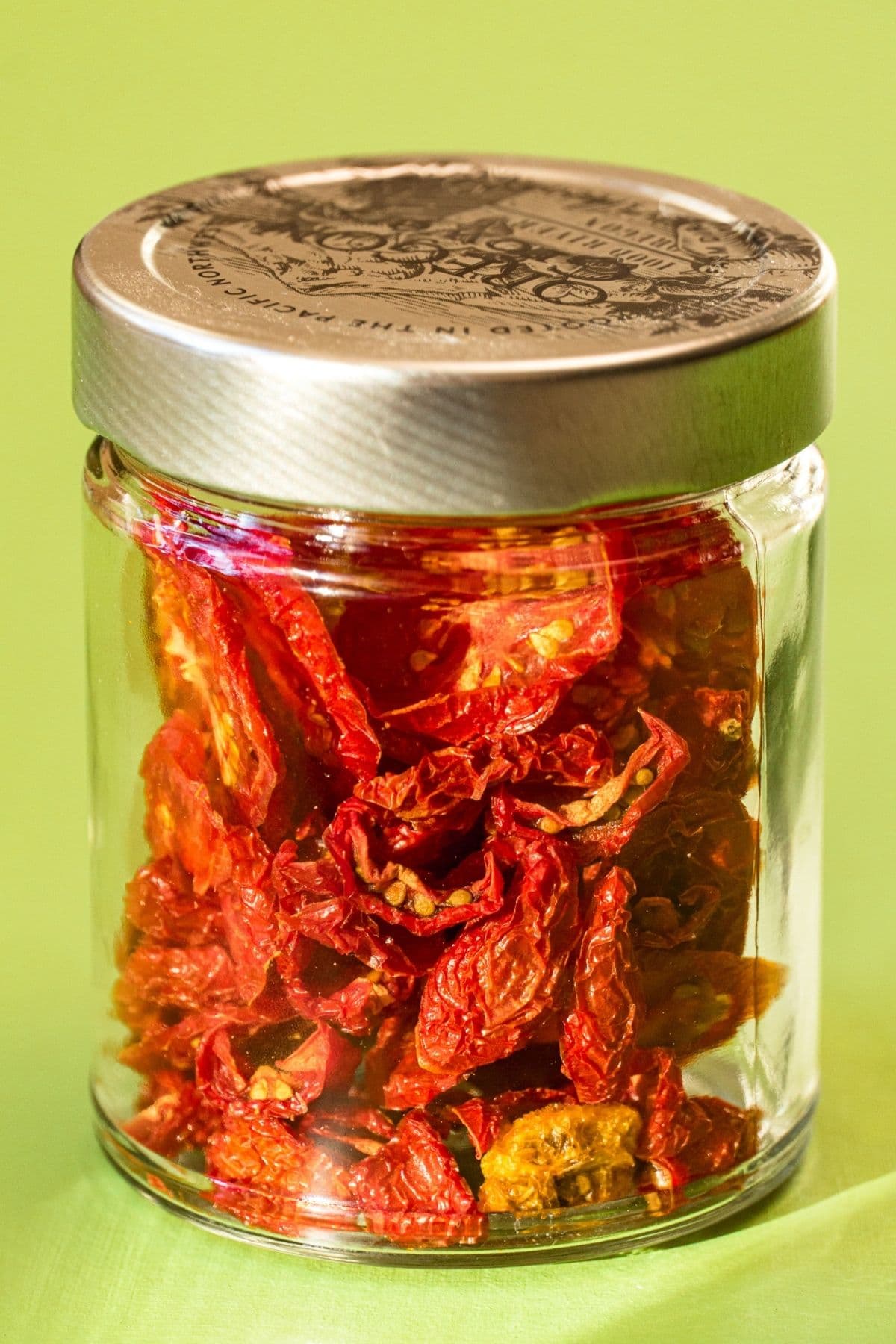
Conditioning Your Dehydrated Tomatoes
Since tomatoes contain so much water, it’s a really good idea to condition them before sealing them up for long-term storage.
- Once the dehydrated tomatoes have cooled to room temperature on the tray, transfer them into a mason jar and screw on the lid.
- Leave the jar out on your counter for upwards of one week. Each day, check the jar to see if moisture is developing on the inside of the glass. Shake the jar to make sure none of the tomatoes are sticking to the glass (or themselves)
- If you see any indication of moisture, return the tomatoes to the dehydrator and continue drying. (unless you see evidence of mold, in which case toss the entire batch).
- After one week, if no moisture is present, you can go ahead and transfer the tomatoes for long-term storage.
How to store dehydrated tomatoes
When properly dried and stored, dehydrated tomatoes can last upwards of a year. Here are our tips for storage:
- Don’t skip the conditioning step mentioned above.
- Store in a clean, airtight container. For longer shelf life, vacuum seal.
- Use a moisture absorbing desiccant packet if you anticipate opening the container often, or if you live in an area with high humidity.
- Label the container with the date and any other important details
- Place the container in a cool, dark, and dry place—inside of a pantry cabinet works well.
Vacuum Sealing Tips
We like to store our dehydrated food in mason jars that have been vacuum-sealed using this handheld FoodSaver vacuum sealer along with these jar sealing attachments. This gives us the benefit of vacuum sealing without the waste (and expense) of plastic vacuum sealing bags. Since the jars are clear we make sure we store them in a dark spot in our pantry to keep them out of direct light.

How to Use
To rehydrate your dried tomatoes, let them soak in boiling water for 10-15 minutes until they become soft and pliable. But they can also be naturally incorporated into a lot of meals as well.
- Use for any recipe that calls for “sun-dried tomatoes”
- Soups, stews, sauces, braises, or anything else that will be heated in a liquid.
- Chop them up and use them to top salads.
- Backpacking meals–Dehydrated tomatoes make a great addition to a variety of lightweight backpacking meals like:

Dehydrated Tomatoes
Ingredients
Equipment
Instructions
- Start with clean hands, equipment, and countertops.
- Prep the tomatoes—slice large tomatoes into ¼" thick slices or cubes. Cherry or grape tomatoes can be halved or quartered. Remove seeds if desired.
- Arrange the tomatoes on dehydrator trays, utilizing a mesh liner to prevent smaller slices of tomatoes from falling through the holes as they shrink.
- Dehydrate at 135ºF (57ºC) for 6-12 hours until the tomatoes are dry and hard—they should not bend (see note 2).
Storage Tips
- Let the dried tomatoes cool completely before storing.
- Short-term storage: If tomatoes will be consumed within a few weeks, store in a ziptop bag or sealed container on the counter or in a pantry.
- Long-term storage: Condition by loosely packing the dried tomatoes in a transparent, airtight container. Leave it on the counter for a week and check it daily for signs of moisture. If condensation appears, return the tomatoes to the dehydrator (unless there are signs of mold—then, throw out the whole batch). Shake occasionally to keep the pieces from sticking together.
- After conditioning, store in an airtight container in a cool, dark place for up to a year. Vacuum sealing will help extend the shelf life and quality of the tomatoes.

